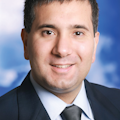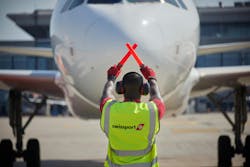In January 2024, the European Union Aviation Safety Agency (EASA) published the first-ever proposal to regulate ground handling across EU airports to increase the safety and consistency of ground operations before and after a flight.
EASA’s opinion, for the first time, is proposing regulations that will affect approximately 300,000 workers in the ground handling industry. The ground handling regulations are expected to be published in late 2024 or early 2025 and EASA has proposed a transition period of three years for implementation after the publication of the regulation.
The Human Element
According to statistics, damage to the aircraft during ground handling activities – in Europe, alone – generates costs estimated to 1.5 billion euros per year, declare EASA officials.
“The real cause or contributing factors could be linked to human factors – poor situational awareness, pressure, fatigue, deviation from the operational procedures; organizational factors – improper training, poor quality management, improper communication, lack of safety culture, faulty operational procedures; or technology-related factors – poor equipment design, poor maintenance; and the list may go on,” explain EASA officials.
“Indicators such as the highest staff turnover in the aviation industry – turning to an annual 70 percent turnover rate post-COVID 19 with some ground handling organizations operating in Europe – coupled with the business need to remain competitive and minimize the costs where possible might contribute to an increased level of safety risk to the entire flight and ground operations,” they add.
The COVID-19 pandemic was a revealing agent, a “litmus test” for the sustainability of the ground handling industry, which helped reveal the real situation in the ground handling sector, according to EASA.
“The problem of staff shortages is expected to exacerbate with the current age profile of ground handling workers, who will soon retire and the younger ground handling workers belonging to the new generations will be significantly fewer,” say officials at EASA.
Regulatory Vacuum
According to representatives at Swissport, EASA’s ground handling regulations will help establish a minimum set of standards that all ground handlers must achieve to address the standing regulatory vacuum.
Currently, in EASA member states there is no harmonized oversight (i.e., verification, surveillance, audits and inspections) of ground handling activities organizations by state competent authorities, according to EASA.
“However, in lack of a proper legal tool for safety oversight, in some member states the national legislation transposing the GH Directive is covering the safety of ground handling operations to some extent,” say EASA officials. “A few member states also use the provisions of Regulations (EU) No. 965/2012 on air operations and (EU) No. 139/2014 on aerodromes to conduct an indirect oversight of ground handling activities through the requirements on contracted services applicable respectively to aircraft operators and aerodrome operators.”
There is no minimum level of safety in ground handling established as a mandatory basis, as ground handling organizations apply a safety management system (SMS) on their activities on a voluntary basis, point out EASA officials.
“The level of safety estimated from submitted reports may be inaccurate, as the reporting culture, safety culture and accuracy of reporting have not been assessed consistently, and there is no clear or consistent feedback loop from competent authorities to GH organizations submitting occurrence reports on ground handling,” say leaders at EASA. “With SMS being implemented only on a voluntary basis, a minimum SMS awareness cannot be ensured across the whole ground handling industry. For ground handling organizations providing services worldwide, the SMS is not an alien concept; often safety awareness and safety culture are well embedded in their organizations.”
Responsibility for the safety of ground handling services so far has been with aircraft operators, as contractors of ground handling services, according to EASA officials.
“The ground handling sector is an active contributor and a key player to aviation safety that should be acknowledged as such by formally recognizing ground handling organizations as an aviation safety stakeholder with an active responsibility to maintain and improve aviation safety,” they say. “Also, there is often no mutual sharing of safety-relevant information between the main safety stakeholders: airports, aircraft operators and ground handling organizations.”
Industry Standards
The minimum level of training for ground handling personnel is not standardized except for organizations that apply industry standards, and it is verified only under the contractual conditions with the aircraft operators, observes EASA representatives.
“Compliance with the training elements for vehicle drivers included in the Aerodrome Regulation is verified by the aerodrome operator, and this is the only training program applicable to GH that is currently standardized at EU level,” say officials at EASA. “Furthermore, large ground handling organizations and aircraft operators affirm that there is a high number of industry audits performed each year to a ground handling organization.
“From our point of view, the resources spent on so many audits that produce the same results are counterproductive and the efficiency of verifying a ground handling organization’s compliance with the requirements and with the operational procedures should be improved,” they add.
For many years, the gap left by the lack of specific regulations has been filled by industry standards such as IATA’s Airport Handling Manual (AHM), IATA’s Ground Operations Manual (IGOM), IATA’s Cargo Handling Manual (ICHM) and Dangerous Goods Regulations (DGR), among others, affirms Monika Mejstrikova, director of ground operations at the International Air Transport Association (IATA).
“The introduction of the IATA Safety Audit for Ground Operations (ISAGO) 15 years ago provided a means for their consistent application across the industry. This collaboration between airlines and ground handling service providers (GHSP) has improved safety performance,” she affirms. “Our advocacy focuses on regulations that are data-driven, risk-based and SMART, aiming to enhance safety, efficiency and risk management in ground handling.”
In the current framework, the audits and inspections performed mostly by aircraft operators under the applicable requirements of Regulation (EU) No. 965/2012 and several also by aerodrome operators under Regulation (EU) No. 139/2014 or, as the case may be, national implementation of the GH Directive 96/67/EC, aim at achieving and maintaining an acceptable level of safety of the ground handling services, according to EASA officials.
“However, the efficiency of those audits can be improved, as evidence shows some extreme, but not singular, cases of worldwide GH organizations spending 178 days a year in answering to third-party audits (over one-third of a year) that come with large costs attached to them, and whose results are 80 percent identical with each other and not able to show any new safety items that the ground handling organization is not already aware of via its own internal SMS system and its own audits,” officials at EASA say.
“In another example, a pan-European ground handling organization with 100 stations is subject to audits conducted by an average of 625 entities (aircraft operators, authorities, aerodrome operators, etc.), resulting in almost 5,000 man-hours per year spent by the ground handling organization in those audits,” they continue. “In other words, this means more than six audits per year per station, i.e. one audit every two months per station, generating a non-productive time requirement of around 50 man-hours per station, in a sector that is already struggling with high levels of staff shortage.”
According to Mejstrikova, a difficulty of regulations is the challenge to swiftly adapt to the ground handling sector’s evolving needs, such as new equipment, automation and digitalization of processes.
“Ensuring uniform implementation also remains difficult, as different states and regulators may interpret requirements differently, posing a continuous challenge. Given that many GHSPs operate globally, not just in the EU, it is crucial for them to standardize their processes worldwide, thus, industry standards are invaluable because they apply universally, across all regions, aircraft types and operations,” she says. “Thanks to the efforts of airlines, GHSPs and airports within working groups, these standards are regularly updated, ensuring their continued relevance and effectiveness.”
Global Perspective
In the domain of ground handling, when considering the term “regulation,” there is a broad spectrum of meanings, ranging from very prescriptive regulations, especially in the Middle East, to the almost self-prescribed approach of volunteering in Latin American countries, affirms Fabio Gamba, director general of the Airport Services Association (ASA).
“Overall, however, most of the countries in the world do not have ground handling regulations in place, which makes it complicated to come up with a consistent approach,” he says.
Depending on the customer, one has to adapt, and this in the longer term may have implications on how one operates, the safety of the operations, as well as the complexity because people have to be trained according to different operational standards, Gamba explains.
“The solution is to make sure that ground handling regulation can be applied not only regionally, which is already a step in the right direction, but also internationally,” he says. “This is why we hope EASA’s ground handling regulations help to create a universal standard.”
About the Author

Mario Pierobon
Dr. Mario Pierobon provides solutions in the areas of documentation, training and consulting to organizations operating in safety-sensitive industries. He has conducted a doctoral research project investigating aircraft ground handling safety. He may be reached at [email protected].
